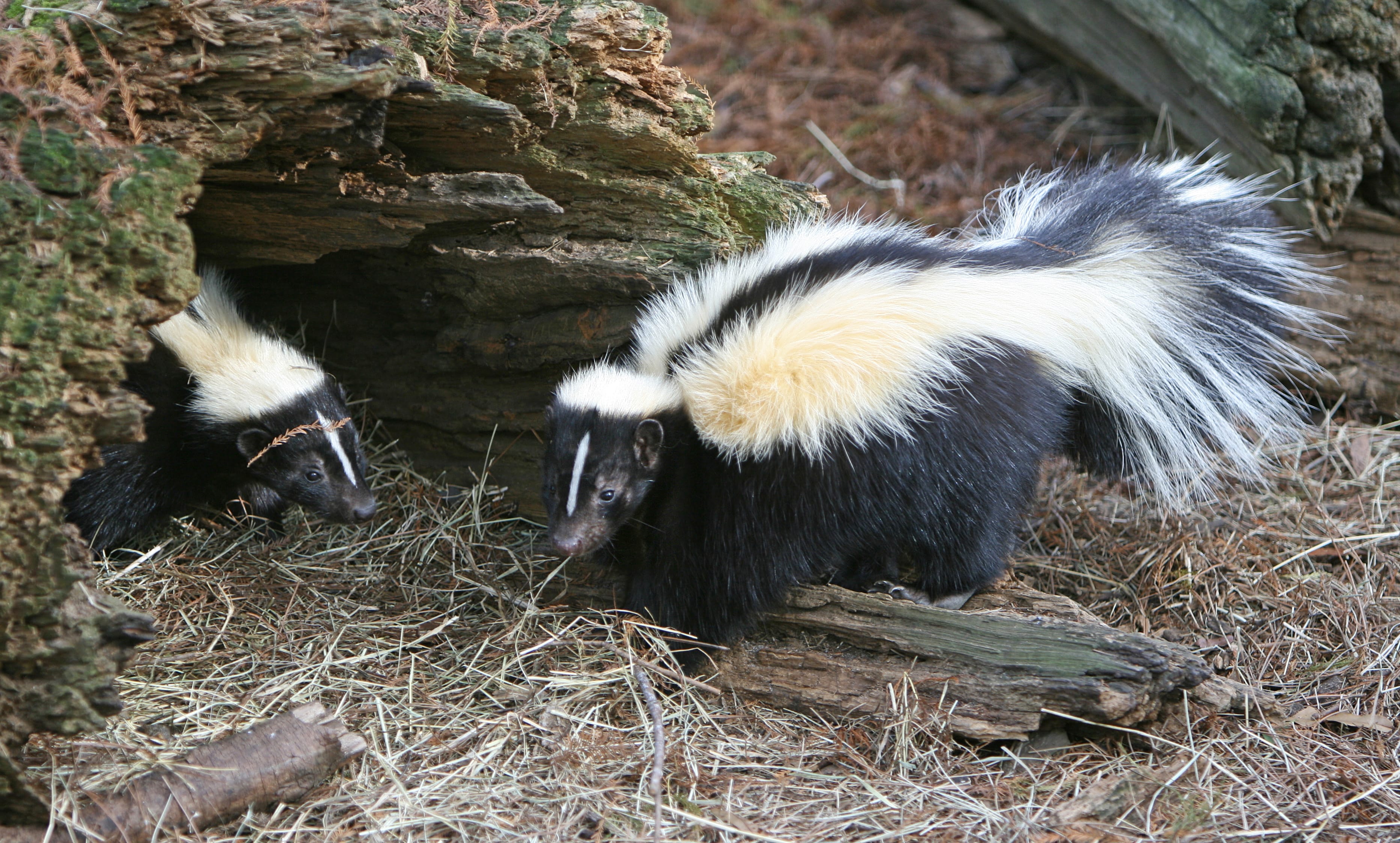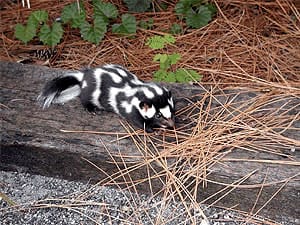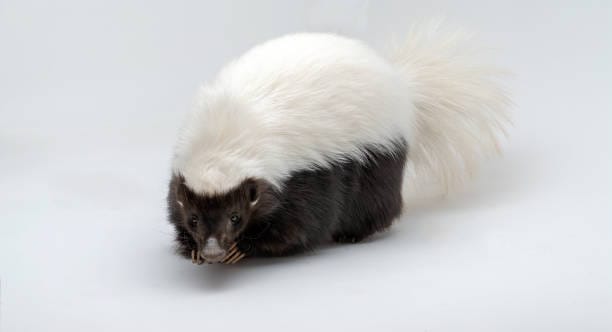Ohio’s woodlands, farmlands, and suburban areas are home to a variety of wildlife, including some of the state’s most intriguing small mammals: skunks. Often remembered for their potent spray, skunks in Ohio play a vital role in controlling insects, rodents, and other pests, making them an important part of local ecosystems. This article dives into the types of skunks in Ohio, detailing their identifying features, behaviors, habitats, diets, and interactions with humans. Whether you’re an avid wildlife watcher or a curious homeowner, understanding these creatures can help you coexist peacefully and appreciate their ecological importance. By the end, you’ll be able to identify each species and understand their life cycles and survival strategies.
1. Striped Skunk (Mephitis mephitis)

Physical Characteristics & Identification Tips
The Striped Skunk is the most familiar skunk in Ohio. Recognizable by its black fur with two bold white stripes running from its head to tail, adults typically range from 20 to 30 inches long, including the tail, and weigh between 6 and 10 pounds. Males tend to be slightly larger than females. Their pointed snout and small, rounded ears give them a slightly inquisitive look. Short, sturdy legs equipped with sharp claws make them excellent diggers, which is helpful when searching for insects and grubs.
Identification is straightforward: look for the signature “V-shaped” stripes on their backs. Watch their posture — if the skunk begins stamping its feet or raising its tail, it’s giving a polite warning to potential threats.
Behavior
Striped skunks are primarily nocturnal and solitary, spending daylight hours in dens or under human structures like porches and sheds. They are generally non-aggressive, relying on scent as a defense mechanism. Their spray, which is a potent mix of sulfur-containing chemicals, can be accurately aimed up to 10 feet. Striped skunks often forage slowly at night, covering small areas efficiently while hunting for insects, grubs, small mammals, and other edibles.
In suburban areas, they have adapted remarkably well, scavenging in gardens, trash bins, and compost piles. Despite their notorious smell, they play a crucial role in controlling pests and are considered beneficial in gardens and farms.
Habitat and Range
Striped skunks are found throughout Ohio, from dense woodlands to open fields and suburban neighborhoods. They prefer areas with cover and nearby water sources. Unlike true hibernators, skunks enter a semi-dormant state during cold weather but may emerge on mild winter nights to forage. Dens are often reused from year to year, including abandoned burrows from other animals.
Diet
Striped skunks are opportunistic omnivores. Insects, small mammals, eggs, fruits, and berries make up the bulk of their diet. Seasonal changes influence their diet; insects dominate during the warmer months, while plant material and small rodents become more important during cooler seasons. This dietary flexibility allows them to thrive in both wild and human-modified landscapes.
Reproduction and Life Cycle
Breeding occurs from late February to early March. Females give birth to 4–6 kits in late spring. Kits are born blind and helpless, relying entirely on their mother for care. They open their eyes at around three weeks and begin exploring their surroundings at about six weeks old. By late summer, young skunks disperse to establish territories. Wild striped skunks typically live 2–3 years, though some individuals may survive up to five years.
Fun Facts / Noteworthy Traits
- A striped skunk can spray up to six times before needing to replenish its scent glands.
- Despite their smelly reputation, skunks are clean animals and groom themselves regularly.
- Predators often avoid them due to the effectiveness of their defensive spray.
Human Interaction
Most encounters are accidental. To minimize conflicts, secure trash bins, remove outdoor pet food, and close access under decks or sheds. If a pet or human is sprayed, a mixture of hydrogen peroxide, baking soda, and dish soap can neutralize the odor effectively.
2. Eastern Spotted Skunk (Spilogale putorius)

Physical Characteristics & Identification Tips
The Eastern Spotted Skunk is smaller and more elusive than the striped skunk. Adults weigh between 1 and 3 pounds and measure 16–24 inches from nose to tail. Black fur with broken white stripes and spots distinguishes it from its striped relative. Its slender build and fluffy tail give it a slightly acrobatic appearance. A distinctive behavior is the handstand they perform when threatened, raising their tail to warn predators — a display both dramatic and memorable.
Behavior
Eastern Spotted Skunks are nocturnal and extremely agile, capable of climbing small trees and squeezing through tight spaces. They are solitary and avoid human activity whenever possible. These skunks forage quietly, feeding on insects, small mammals, fruits, and eggs. Their elusive behavior and preference for dense cover make them less visible than striped skunks, even in areas where both species overlap.
Habitat and Range
Spotted skunks are scattered throughout Ohio but are less common than striped skunks. They favor overgrown fields, brushy edges, and rural woodlands. They often occupy dens from abandoned burrows or hollow logs. Maintaining brushy areas and reducing pesticide use supports their populations, as they rely heavily on insect prey.
Diet
Omnivorous but insect-focused, Eastern Spotted Skunks feed on beetles, grasshoppers, moths, and other invertebrates. They also consume small rodents, eggs, and seasonal fruits. Their diet makes them valuable natural pest controllers, though they are often unnoticed due to their secretive nature.
Reproduction and Life Cycle
Breeding occurs in late winter, but implantation is delayed until spring. Litters typically consist of 4–5 kits, which remain with the mother until early summer. Spotted skunks usually live around three years, and survival depends on avoiding predators and finding sufficient food and shelter.
Fun Facts / Noteworthy Traits
- The handstand display is a defensive behavior unique among skunks.
- They can climb, unlike most other skunk species.
- Although smaller, their spray is potent enough to deter most predators.
Human Interaction
These skunks rarely appear in urban areas. Observing them from a distance is safest. Conservationists recommend leaving brushy edges intact to maintain their habitat and avoid unnecessary pesticide use.
3. Hog-Nosed Skunk (Conepatus leuconotus) — Rare Visitor

Physical Characteristics & Identification Tips
The Hog-Nosed Skunk is larger than the other skunks in Ohio, weighing up to 15 pounds. It has a pale dorsal stripe and a pig-like snout adapted for digging. While it is not a regular resident in Ohio, occasional wanderers may appear in the southwestern or western parts of the state. Its appearance is easy to distinguish from striped and spotted skunks due to the long snout and wide, pale stripe.
Behavior
Primarily nocturnal and solitary, Hog-Nosed Skunks rely heavily on digging for insects, grubs, and plant roots. They use their strong forelimbs and long snouts to overturn soil efficiently. Like other skunks, they display foot-stomping and vocal warnings before spraying when threatened.
Habitat and Range
Native to the southwestern United States and Mexico, Hog-Nosed Skunks are rare in Ohio. Their preferred habitats include open fields, scrublands, and forest edges. Reports of sightings are occasional and exciting for local wildlife enthusiasts.
Diet
They feed primarily on insects and other invertebrates, as well as roots and fruits. Their digging activity helps aerate soil and control pest populations, making them beneficial to the ecosystem even as rare visitors.
Reproduction and Life Cycle
Breeding occurs in early spring, and litters typically include 2–6 young. Kits stay in the den for several weeks before accompanying the mother on nocturnal foraging. In the wild, they can live up to four years.
Fun Facts / Noteworthy Traits
- The long snout is specialized for rooting out insects and tubers.
- They have a single broad dorsal stripe unlike the multiple stripes or spots of other skunks.
- Rare visitors may surprise residents, contributing to wildlife diversity in Ohio.
Human Interaction
Although sightings are rare, Hog-Nosed Skunks can help manage insect populations. Observing and reporting sightings aids wildlife agencies in tracking their potential expansion.
Conclusion
The types of skunks in Ohio — Striped Skunk, Eastern Spotted Skunk, and the rare Hog-Nosed Skunk — each play important ecological roles. They control insect and rodent populations, improve soil quality, and provide fascinating insights into Ohio’s nocturnal wildlife. While their defensive spray is memorable, their presence benefits the environment. Understanding these species helps humans coexist safely while appreciating the diversity of wildlife Ohio has to offer.
Frequently Asked Questions About Skunks in Ohio
1. How many types of skunks are found in Ohio?
Ohio has two confirmed skunk species — Striped Skunk and Eastern Spotted Skunk. Hog-Nosed Skunks are rare visitors.
2. Which skunk is most common in Ohio?
The Striped Skunk (Mephitis mephitis) is the most frequently seen skunk in Ohio.
3. Where do skunks live in Ohio?
Skunks inhabit woodlands, fields, farmlands, and suburban areas, often near water and shelter.
4. Are skunks dangerous to humans or pets?
Skunks are generally not aggressive. Their main defense is spraying, but they can carry rabies.
5. What do skunks eat in Ohio?
Skunks are omnivorous, feeding on insects, small mammals, eggs, fruits, and berries.
6. When are skunks active?
Skunks are nocturnal, mainly active at night with peak activity around dusk and dawn.
7. Do skunks hibernate in Ohio?
They do not fully hibernate but may enter torpor during very cold periods.
8. How can I tell a striped skunk from an Eastern spotted skunk?
Striped skunks have two continuous stripes, while Eastern spotted skunks have broken stripes and spots.
9. Are Eastern Spotted Skunks endangered in Ohio?
Eastern Spotted Skunks are a species of concern due to habitat loss and pesticide use.
10. How far can a skunk spray?
Skunks can spray up to 10 feet with remarkable accuracy.
11. What should I do if a skunk sprays near my house?
Ventilate the area and clean using a mix of hydrogen peroxide, baking soda, and dish soap.
12. Can skunks climb trees?
Eastern Spotted Skunks can climb small trees; striped skunks are mostly ground-dwelling.
13. How long do skunks live in the wild?
Wild skunks typically live 2–3 years, though some may survive up to 5 years.
14. What attracts skunks to yards?
Food, trash bins, pet food, grubs, and shelter under decks attract skunks.
15. How can I humanely keep skunks away?
Seal access under decks, remove outdoor food, and consider motion-activated lights or sprinklers.
16. When do skunks have babies?
Breeding occurs in late winter; kits are born in spring.
17. Are skunks good pets?
No. Keeping wild skunks as pets in Ohio is illegal and not recommended.
18. Why do skunks raise their tails before spraying?
Tail raising signals danger and is a warning to predators before spraying.
19. How do skunk tracks look?
They show five toes with claw marks, smaller than raccoon tracks.
20. What predators hunt skunks in Ohio?
Predators include owls, foxes, bobcats, and coyotes, though many avoid skunks due to their spray.
21. Do skunks help the environment?
Yes, they control insects and rodents and improve soil health through digging.
22. What should I do if I find a baby skunk alone?
Observe from a distance; the mother may be nearby. Contact a licensed wildlife rehabilitator if truly abandoned.
23. Are skunks common in suburban Ohio?
Striped skunks are common; Eastern spotted skunks prefer rural, brushy habitats.
24. How do skunks communicate?
They hiss, growl, stomp their feet, perform handstands (spotted skunks), and scent-mark territory.
25. Can skunks dig under fences?
Yes, they are excellent diggers. Burying fences 12 inches deep and angling outward can help prevent entry.
26. What is the rarest skunk in Ohio?
The Eastern Spotted Skunk is rare and elusive, making it less commonly observed.
27. Have Hog-Nosed Skunks ever been seen in Ohio?
They are rare visitors with occasional unconfirmed sightings in the state.
28. Do skunks carry diseases?
Yes, including rabies. Avoid handling skunks or their carcasses.
29. What should I do if my pet is sprayed?
Wash them with a mixture of hydrogen peroxide, baking soda, and dish soap, avoiding eyes and mouth.
30. Do skunks make sounds?
Yes, they hiss, growl, or chirp when threatened or communicating with kits.
31. What time of year are skunks most visible?
Early spring and late summer, during breeding and when young begin exploring.
32. How can I tell if a skunk is living under my shed?
Look for small holes, musky odors, soil disturbance, and nighttime digging noises.
33. Can skunks swim?
Yes, they can swim to escape predators or cross short distances, but they prefer dry ground.
34. Are skunks protected in Ohio?
Yes, skunks are considered furbearers, and handling/removal should be done by licensed professionals.
35. Why are skunks important to Ohio ecosystems?
They manage insect and rodent populations, disperse seeds, and enrich soil.
36. How can I safely observe skunks in Ohio?
Use a flashlight at night from a distance and avoid startling them.
37. What is the difference between striped and hog-nosed skunks?
Hog-Nosed Skunks have a pig-like snout and pale dorsal stripe; striped skunks have bold black-and-white stripes.
38. Can skunks spray more than once?
Yes, striped skunks can spray several times before needing to replenish their scent glands.
39. Do skunks dig for food?
Yes, skunks are skilled diggers, uncovering insects, grubs, and plant roots.
40. Can skunks climb fences?
Some species, like the Eastern Spotted Skunk, can climb short fences; striped skunks are mostly ground-based.
41. Are skunks active during the day?
Rarely. Skunks are mostly nocturnal and only active during the day if food is scarce or disturbed.
42. How do I deter skunks from my garden?
Remove food sources, secure compost, and use fencing or motion-activated deterrents.
43. Can skunks carry fleas or ticks?
Yes, skunks may carry external parasites. Limit direct contact and keep pets protected.
44. What should I do if I see a skunk in my yard?
Keep your distance, secure pets, and observe quietly; avoid sudden movements to prevent spraying.
45. How do skunks mark territory?
They use scent glands located near the tail to mark territory and communicate with other skunks.
Read more: 3 Types of Skunks in Tennessee (Pictures And Identification)
